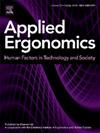Proof of concept of a cobotic system in a constrained work environment
IF 3.1
2区 工程技术
Q2 ENGINEERING, INDUSTRIAL
引用次数: 0
Abstract
Objective
This study is a proof of concept that aims to measure the impacts of a human/cobot collaboration on the human and his task during a simulated chemistry assembly.
Background
The 5th industrial revolution calls for refocusing work on the human operator, placing him or her at the center of the system. Thus, cobotic systems are increasingly implemented to support human work. In this research, we study the impact of a real-life cobot on the performance (e.g. number of errors, time completion), workload, risk exposure and acceptability of participants realizing an industrial-like assembly task.
Method
Participants had to reproduce an assembly model with Duplos in collaboration with a cobot in a laboratory setting. The effect of the human expertise on the task (prior to the collaboration) and the level of cobot adaptation to human safety constraints on the performance at the task and on operator were tested.
Results
The main results report that expert participants did less mistakes and were less exposed to risks than non-experts. However, both of them succeeded in the task thanks to the cobot adaptation. Also, the cobot was able to adapt to human safety constraints. This adaptation led participants to expose themselves to fewer risks. Also, contrary to previous findings, experts had a similar score of acceptability than non-experts.
Conclusion
This laboratory experiment is a proof of concept demonstrating that using a cobotic solution could potentially assist humans in supporting high-risk work operations.
Application
Cobotic system designers and work designers could benefit from this research's exploratory results when supporting the design of constraints in workstations for high-risk work operations.
在受限的工作环境中验证机器人系统的概念
本研究是一个概念验证,旨在测量在模拟化学组装过程中人类/机器人协作对人类及其任务的影响。第五次工业革命要求将工作重点重新放在人类操作员身上,将他或她置于系统的中心。因此,机器人系统越来越多地用于支持人类工作。在本研究中,我们研究了现实生活中的协作机器人对实现类似工业装配任务的参与者的性能(例如错误数量,完成时间),工作量,风险暴露和可接受性的影响。方法参与者必须在实验室环境中与协作机器人合作,用Duplos再现装配模型。测试了人类专业知识对任务的影响(在协作之前),以及协作机器人对任务性能和操作员的人类安全约束的适应水平。结果主要结果表明,专家参与者比非专家参与者犯的错误更少,暴露的风险更少。然而,由于协作机器人的适应能力,他们都成功完成了任务。此外,协作机器人能够适应人类的安全限制。这种适应使参与者暴露在更少的风险中。此外,与之前的发现相反,专家的可接受性得分与非专家相似。这个实验室实验是一个概念验证,表明使用机器人解决方案可以潜在地帮助人类支持高风险的工作操作。应用机器人系统设计人员和工作设计人员可以从这项研究的探索性结果中受益,当支持高风险工作操作工作站的约束设计时。
本文章由计算机程序翻译,如有差异,请以英文原文为准。
求助全文
约1分钟内获得全文
求助全文
来源期刊

Applied Ergonomics
工程技术-工程:工业
CiteScore
7.50
自引率
9.40%
发文量
248
审稿时长
53 days
期刊介绍:
Applied Ergonomics is aimed at ergonomists and all those interested in applying ergonomics/human factors in the design, planning and management of technical and social systems at work or leisure. Readership is truly international with subscribers in over 50 countries. Professionals for whom Applied Ergonomics is of interest include: ergonomists, designers, industrial engineers, health and safety specialists, systems engineers, design engineers, organizational psychologists, occupational health specialists and human-computer interaction specialists.
 求助内容:
求助内容: 应助结果提醒方式:
应助结果提醒方式:


